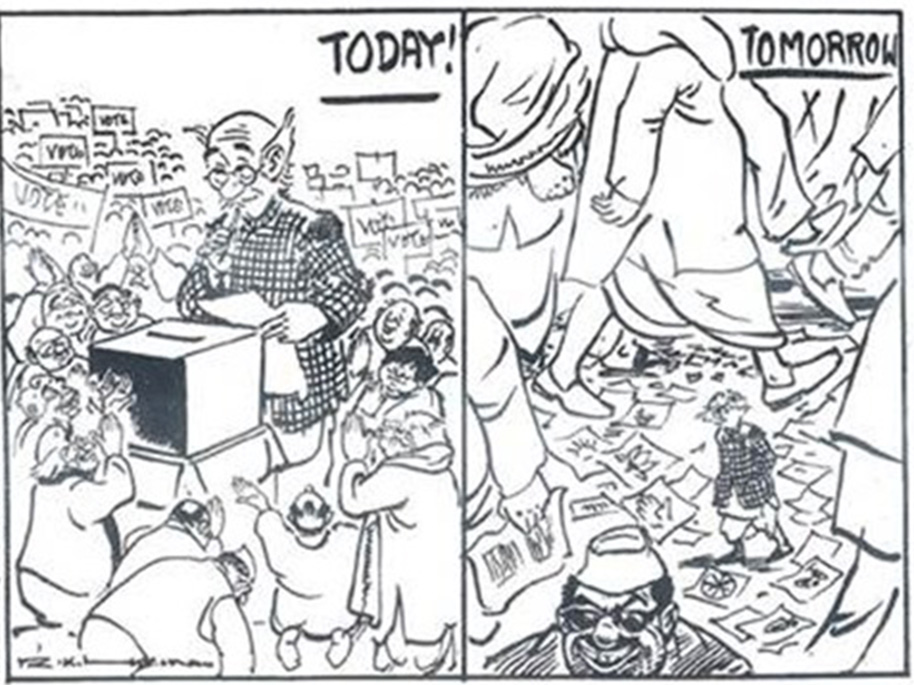Soumabrata Chatterjee reminisces about R K Laxman and the role of a public intellectual in shaping the society.
In the beginning it was the Word. Well, apparently so.
If we could just imagine the word to be the miniature form of what is popularly celebrated as ‘discourse’, then we could grasp the fecundity of being a person who can wield a pen, a brush, a typewriter, and a spray can to create something revolutionary out of the banality that encompasses our mundane existence.
Word is thus the smallest unit of speech, which can refer to the intricate relation between power and knowledge, as it exists in the contemporary paranoiac world of images. It is that minute space which can potentially disrupt organisations, hegemonies, cultures and so on… It embraces the dialectic between participation and disenchantment, between culture and counter-culture, between structure and form, between the general and particular.
If we could just understand the signifying power that this construct carries till today, then we would understand why R K Laxman was a rebel, an anarchist, a critic in the proper, immaculate sense of the words.
He is no more.
But his images stay with us, ones he created sitting in his library, his work place, his drawing room, in his mindscape. They stay as remainders of his unbridled passion for critiquing, as remnants of a slowly decomposing culture of writers who use their pen to answer back, to disrupt the structures of oppression that has plagued the modern nation-state.
However, we need to gauge why he wrote… Why didn’t he create utopic futures where the world was a blissful place? Why didn’t he create dystopian futures where he could show you fear in a grain of useless dirt? Why didn’t he create hollow men and make them dance to a tragicomic tune which showed the basic futility of man’s endeavour? Why didn’t he create the absurd non-character who struts and frets on the stage and is heard no more? Why didn’t he create the Fool who bares his chest on an empty stage? Why did he create the common man?
The culture of talking back, I guess, comes naturally to a satirist. R K Laxman also occupied the problematic position of a public intellectual who pokes fun at the alliterative quality imbued in governmentalities that tend to silence protestors through violence. His role as an intellectual forced him to be an ‘outsider’… a person who is tempted to say “I would prefer not to” as in the famous novel Moby-Dick.
This outsider-hood, this self-imposed oblique consciousness is what specifies the modern public intellectual in uncertain terms. This position is of course reactionary, to say the least. But it is not pernicious to the wellbeing of the welfare state. Rather it is reformative. It is therapeutic. But at the same time, it retains a sense of being different. The common is the most homogenised element around, he is co-opted in every form of procedure, he is comical in his truisms that he holds so close to his heart, he is tragic in all the failures that define him and even cut his long shadow short, so to speak… Yet he notices everything… He is a spectator, he is not a voyeur… Even though he roams around quite aimlessly he walks through spaces, which do not form a continuity… He creates his own space… his voice, his art of intervening in the most curious of situations. He evokes laughter, at himself, at others, at society and its predilections. He is the silent viewer and yet his vote brings down years of homoegeneity and oppression. Why did literature forget this man? Why did cinema stop making this man their hero? Why do all heroes have to be buffed up? Or, stereotyped as hapless men searching for a way to float above obstacles? Where is the common man who can register his protest in a unique manner quite unsavoury to those high theoreticians and those custodians of the society?
The common man was R K Laxman’s weapon of choice, his partner in social commentary. His common man appeared in the most unassuming of places, lived in unrestrained obscurity, never created a fuss, recorded the events, employed the notion of gaze and caused a disruption through the act of viewing… yet, he was not deliciously numb. He reacted, he acted…He knew that his words, his discourse of pushing the boundaries may never succeed but he was content with the act of resistance.
The post-independence, post-liberal world became a burial site for the common man. India progressed in shouts and whispers and the multitudes that formed the electorate were neutralised over time and space. Religion muffled their right to be non-conformist; fake political promises bombarded their way into their dream-infested mindscapes; political consciousness became mass culture; individualism gave way to painstaking stereotype. That’s why Laxman’s common man was an Everyman; he was a faceless man among millions yet he retained a distinct flavor, that of being put under the carpet for long… Laxman’s common man didn’t break the system but certainly provided a viable way of critiquing it. In fact, his visibility was itself a critique. “He was bald and bespectacled . . . He had a permanently bewildered look and was dressed in a dhoti and a checked coat. This man finally minimized my deadline agonies and took over the strenuous task of representing the mute millions of the country” … Laxman said about his common man.
But then, my crude mind tried to write outside the sentence, so to speak. Why was it a common man? Why couldn’t it be a common woman? It could be argued that pre-colonial or pre-independence women didn’t have a valid incisive viewpoint though that would be historically wrong and downright stupid. What can be said unequivocally though, is that post-liberalisation India has seen its women undercut the status quo more than one historian can catalogue. Was it the ‘natural way’ to view things? Will man ever be the normative and woman the quintessential marginalised? We thought that the common man was subjugated but at least he can cartoonise his position and through his gaze appropriate the development of the Indian nation. How can a woman imagine? How can she critique if her position is always in relation to the category of man, even in a politically incorrect cartoonist’s mind? By excluding women from the privileged position of the spectator is he being politically correct or incorrect or both? The woman is invisible; she exists as an extended metaphor in the political landscape that the intellectual has fabricated. It can be questioned after we have leafed through the history of feminist struggle, that the predominance of the masculine lens is a matter of choice, not of compulsion.
Then why is R K Laxman special to me? As a modern public intellectual, he stands for the old humanitarian ideals and social activism that actually strives to bring about a change. But his – a shrewd cynicism mingles with his ideal of activism, which can be romantic to a certain extent, He represents, for me, the Saidian ideal of speaking “truth to power.” Partly inspired by his exilic consciousness and partly by his intellectual predecessor Theodore Adorno and his concept of “non-dominative difference”, Edward Said talks about how the intellectual always has to be an outsider, assuming a position of exteriority, negotiating the changes of the governments, interpreting the checks and balances and ultimately choosing a side or step which he thinks is necessary. He believes in an egalitarian world where there is a space for multiple cultures to mingle and interact with each other. He proposes a world where the dissenting voices do not have to be silenced, where words do not have to be curtailed at the altar of manufactured aggression, where books do not have to be burned, where famished bodies don’t need sympathising anecdotes, where freedom and democracy are both private and public.
But as Terry Eagleton proclaimed the days of high theory are gone. What remains is a world tarnished with and cut through by more than fifty shades of grey. So how can a common man dream? Is his fantasy like his material experience has to be shabby? No, says R K Laxman. He does not intend to obscure his idealism with overbearing words like postmodernism and a hell lot of other –isms. But he knows that the old-school Marxist ideal of dreamy-eyed revolution is a story long defeated. What does he do? He creates a person who obscures the boundaries… the private and public… He doesn’t make them fluid so that his artist may move beyond them… He creates a parallel movement of dislocation. His common man is seen at the summits, conferences, beside government officials, standing almost nonchalantly, nothing manly or sinewy about him. Yet he scribbles some words beneath which undercut the generalities of the situation. He highlights the deeply fraught society that we live in… He speaks ‘truth’… This is not a fashionable thing to say anymore at the face of relativism and perspectivism but he understands that too. He speaks his own truth, the truth imagined and created by his quintessential common man who feel the burden of religion, caste, class… and yet his creator is somewhat secular in his idealism.
This is to say R K Laxman never cut down his possibilities and foibles… He was not senile about his attitude, rather he was hearty and jovial in the manner of celebrating difference, humanism and secularism at the face of a society which challenged all these notions.














